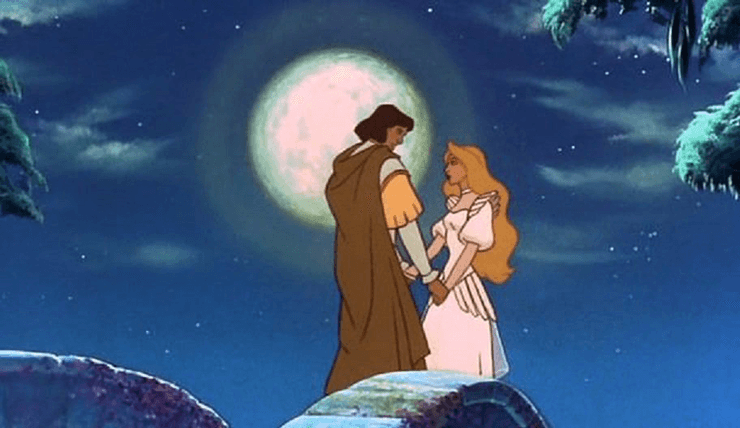The animation studios at Disney in the 1980s could be a rather stressful place, to put it mildly. Even for an animator who had started with the 1973 Robin Hood, continued through the 1977 The Rescuers, and eventually found himself directing the 1981 The Fox and the Hound, which if not exactly one of Disney’s all-time great success stories, had earned a solid profit on its initial release, and would later continue to bring the company steady earnings from video and streaming sales.
Unfortunately, after these mild successes, Disney executives thought it would be a good idea to assign that animator, Richard Rich, to help direct the already troubled production of 1985 The Black Cauldron. Like many seemingly good ideas in Disney history, this one turned out poorly. Rich ended up having “creative differences” with multiple people assigned to the project, including then-animator Tim Burton, screenwriter Rosemary Anne Sisson, animators John Musker and Ron Clements (who slid over to The Great Mouse Detective and thus, managed to transform later Disney history) and, most importantly, newly arrived Disney chairman Jeffrey Katzenberg, who, in a moment retold in awed voices years later, was allegedly so horrified—or infuriated—by his first viewing of The Black Cauldron that he grabbed the film from the animators and started making his own edits.
Rich decided it was time to leave. Possibly time to start his own studio. Definitely time to think of creating his own film about a fairy tale princess. Perhaps with a connection to ballet.
The eventual—very eventual—result: The Swan Princess.
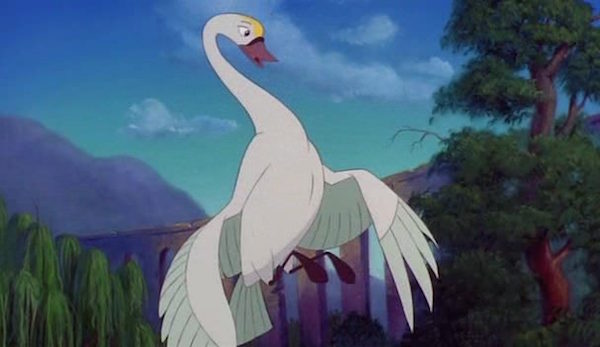
Very eventual, because by the time Rich left Disney in the mid-1980s, no other Hollywood studio wanted to make animated flicks. Oh, sure, Steven Spielberg’s Amblin Entertainment was working with Robert Zemeckis and Disney on a live-action/animated cross called Who Framed Roger Rabbit, and John Musker and Ron Clements were just starting to sharpen their skills on The Great Mouse Detective, but Hollywood had not seen a genuine animated hit since the 1977 The Rescuers—and even that was only a “hit” by comparison; film executives could (and did) argue that the last real hit had been back in 1967, with The Jungle Book. If Disney wanted to keep pouring money into animated films because to help their brand, that was all fine, but not something anyone else wanted to invest in.
That is, until the surprising success of the 1989 The Little Mermaid and the 1991 Beauty and the Beast—which convinced executives that yes, audiences might show up for animated films. Well, animated films based on fairy tales, at least—Disney’s 1990 The Rescuers Down Under, while an important film for animation history, had not exactly broken box office records. Still.
That, finally, was enough to give Rich the financial backing and film distributors he needed—if he stuck to a fairy tale film.
Rich lacked access to both Disney’s just created CAPS system and the new computer animation techniques then just under development at still fairly new Pixar—a company which had yet to create an actual film. Which was perhaps as well, since he also lacked access to the computer processors capable of handling these new techniques—something even then proving to be an engineering challenge for both companies. Since his own training had been in hand animation in any case, he decided to return to the old Disney style of hand-painted animation cels—beautiful, tedious and time consuming—something Disney had abandoned because it was simply to expensive. For Disney. This did lead to The Swan Princess earning the dubious honor of being the last feature length animated film to be entirely hand painted, but also slowed down production, forced Rich to hire more artists, and raised costs—which in turn, forced Rich to cut corners. Even with those cut corners, around 275 animators and artists eventually ended up contributing to the film. Some, like Rich, were Disney escapees. Others worked in between television animation jobs. The mixed quality and training of the animators, combined with the budget cuts, meant that the quality of the final animation work was as mixed as the talent.
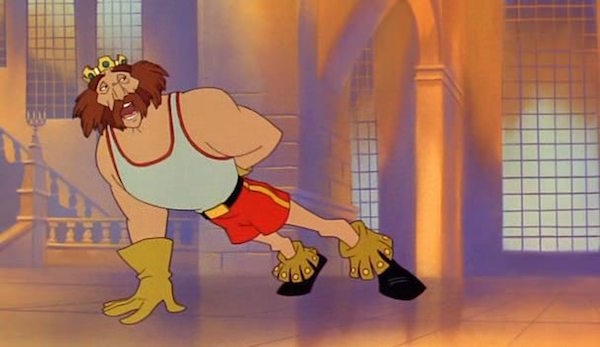
The success of The Little Mermaid did mean that Rich could and did attract some top vocal talent—including Jack Palance, who, before the film’s release, would amuse Oscar watchers by performing one handed pushups on stage right after finally winning his first Academy Award at the age of 73, for City Slickers. (It was a moment, I assure you. A moment. The Swan Princess thinks so too.) Other top vocalists included comedians John Cleese along with Steven Wright, whose addition to the film was greeted at the time with conversations like this:
Person 1: Steven Wright? In an animated movie? Are we talking about the same Steven Wright?
Person 2: He’s playing a turtle.
Person 1: (pause.) Oh. Well. I guess that works.
Surprisingly, it actually does.
I was also delighted on this viewing to see Joel McKinnon Miller in the credits, voicing the comparatively minor role of Derek’s friend Bromley. You might know him a bit better as Scully in Brooklyn Nine-Nine.
But that was just the speaking stuff. Rich also wanted his film to have songs, and a lot of them, like the great Disney films. Apparently not completely trusting his voice actors, he hired separate vocalists for most of the singing parts. Most: surprise casting Steven Wright continued to surprise here, by mostly talking through his singing parts. Like the entire turtle bit, it actually kinda works. Like the animation, the doubled voices were a mixed success. The bland singers for main characters Derek and Odette blended in well enough with the bland voice actors, but when it came to the more distinctive tones of Jack Palance and, much worse, John Cleese, the substitution was audible and distracting. Lex de Azevedo (who also wrote the music for the songs) at least made a brave if failed attempt to mimic the rough tones of Jack Palance, but David Zippel (who wrote most of the lyrics) made no attempt to mimic John Cleese’s voice other than putting on a fake French accent more or less entirely unlike Cleese’s fake French accent.
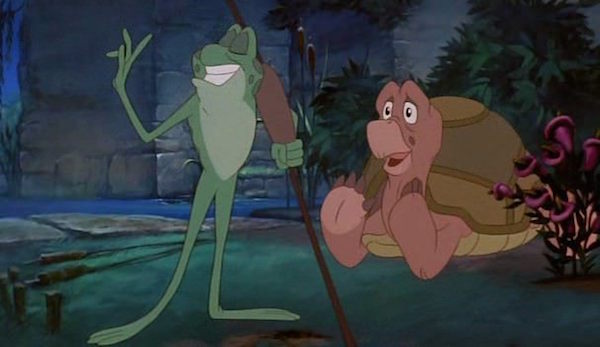
This did have the advantage of allowing Zippel to sing parts of the song he helped write. But otherwise—well. John Cleese may be less of a singer than fellow Python alum Eric Idle, but the song featuring this substitution is a comedy song, featuring Steven Wright talking, no less, and well within Cleese’s range. (I also don’t know what people in France thought about any of this, but I’m guessing it wasn’t kind.)
It’s especially odd given that recent Disney films had featured actors who could and did sing in their roles (well, arguably not Buddy Hackett and David Ogden Stiers, but The Little Mermaid and Beauty and the Beast solved that problem by just not having their characters sing), and given that Rich wasn’t just influenced by those films, he basically wanted to remake them—and other classic Disney fairy tale films. So why not follow their recent examples?
Especially given everything else he followed from those films.
The Swan Princess starts with an opening narration (as in Beauty and the Beast) and Disney’s trick of starting a film by making a camera seem to be entering a painted picture (as in Pinocchio, Peter Pan, Cinderella, The Jungle Book, and several more), a trick that mostly served to remind me that Rich did not have access to Disney’s multiplane camera. We then meet King William, unhappy because he has no child to inherit his throne. “Then,” the narrator tells us, “happily, a daughter was born to him, and she was given the name Odette.” I’m not entirely sure how happy this event really is, given that Odette’s mother is nowhere to be seen (as in The Little Mermaid and Aladdin), and thus presumably did not survive the childbirth experience, but, moving on.
Various royals and aristocrats then come to meet the baby princess (shades of Sleeping Beauty, to the point of mimicking the costumes, art design and even the angles of the previous film), including young Prince Derek and his mother, Queen Uberta, though young Prince Derek is unimpressed (Sleeping Beauty again). At this point, William and Uberta decide that they will make the two kids spend every summer together in the hopes that they will fall in love and unite the two kingdoms.
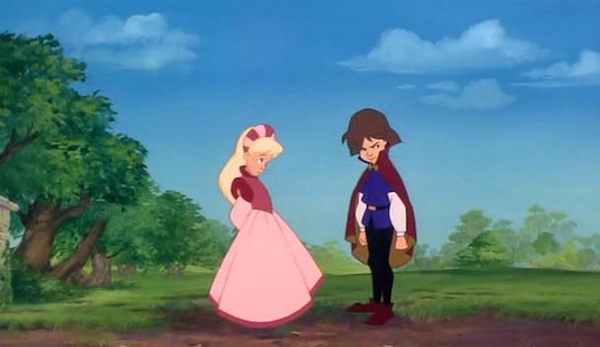
I have questions. Starting with, if this kingdom uniting is so important, why don’t William and Uberta get married, and continuing with, if that’s impossible, then why not follow the long held custom of royalty and just order them to get married (I know, I know, it’s because it’s a 20th century animated film, not an attempt to show a realistic depiction of what I think is meant to be 17th or 18th century life—the clothes are basically “generic fairy tale,” not particularly focused on any given period) and also continuing with, why on earth do these two people think that forcing two kids to spend time together each summer will make them fall in love? I mean, ok—SPOILER ALERT—in this case it actually works, but it does seem like a bit of a risk.
I’m not the only person with objections. Also in the room is Rothbart, an evil enchanter, who wants to take over the kingdom and is not all that into baby princesses. William banishes Rothbart, who promises to return and take everything William owns. Look, Rothbart. Banishment’s not that bad. Think of the travel opportunities.
Meanwhile, little Odette and Derek are forced to get together every summer so they can fall in love. What they actually do is start singing, initially about how they would both rather get chicken pox (trust me kids, you don’t) and that this is not their idea of fun. This leads into a song sequence where both Odette and Derek sing about their feelings, with a chorus of minor characters jumping in to add comment (Beauty and the Beast, with a couple of frames taken from The Little Mermaid and The Rescuers), complete with the slightly uncomfortable sight of servants and laborers working hard at cleaning and building fences while Derek and Odette destroy things, play cards, and lounge around reading (Beauty and the Beast again, though this time unintentionally). Royalty.
Eventually, they fall in love, and find themselves dancing first in a ballroom watched by various aristocrats, and then against a background of colorful clouds, in a moment stolen directly from Sleeping Beauty.
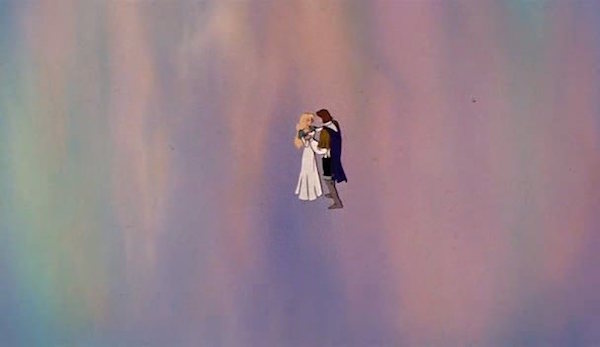
There’s homage, and then there’s outright theft, and then there’s outright theft with comparatively lackluster admiration. Admittedly, virtually no hand-drawn animation, apart from a few scenes from Fantasia and Pinocchio, can survive a comparison with Sleeping Beauty, but that should probably be taken as a sign not to try.
One point to Rich, though—the crowds of background aristocrats do include one or two black people, and in a later scene, a different black character briefly sings. If not exactly the most diverse moment in animation history, this was more than Disney had managed in Snow White and the Seven Dwarfs (which, to be somewhat fair, didn’t have any background aristocrats), or in pretty much any of their later fairy tale films right up to The Princess and the Frog. It was a small touch, but it was something.
Anyway. From here, Derek announces that he’s ready for the wedding. Odette is not, which leads to this bit of dialogue:
Derek: What? You’re all I’ve ever wanted. You’re beautiful.
Odette: Thank you. But what else?
Derek: What else?
Odette: Is beauty all that matters to you?
Uberta: Derek. What else?
Derek: What else is there?
Naturally this ends things.
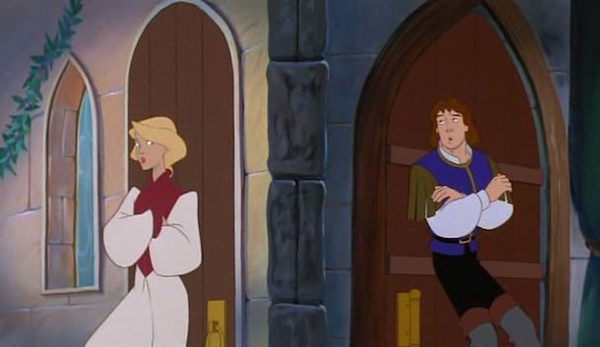
Points to The Swan Princess for including a scene that insists that women deserve to be appreciated for more than their physical appearance. Minus several other points, including, but not limited to, (1) the problem that this entire conversation happens in front of their parents, aristocrats and several musicians, so it’s not at all surprising that Derek, put on the spot, chokes, but (2) he’s never given a chance to clear things up privately with Odette later, and (3) by this point, Odette has spent every single summer with Derek, knowing him better than anyone else in the world other than arguably her father. Indeed, as far as the film shows, her only friends in the world at this point are Derek and Derek’s friend Bromley. She later gains three animal friends, but we never see her with another human friend.
That is, Odette knows, or should know, Derek very well by this point—indeed, just a half hour or so later, the film shows us that yes, she does know him very very well indeed. The plot even depends on just how well she (and Bromley) know Derek. If she really thinks he’s this shallow, why was she falling for him just seconds earlier? Also, given that the song made it very clear that pretty much everyone in both kingdoms, right down to the servants, is expecting and hoping for this marriage, would the wedding really be cancelled over this? Especially given that the two are in love?
So this entire conversation makes very little sense in context, and (4) is completely dropped by the film in any case (we never do learn “what else is there”) because (5) it’s here only to give a plot reason to separate Derek and Odette while convincing us they were in love. I can think of several other ways to get there, and for that matter, make the film work without having Derek and Odette fall in love in the beginning of the film—but that would have ruined the song, and this film’s plot and character development, often to its huge detriment, is generally driven by the songs.
Anyway, I’ve now spent more time on this than the film does, which needs to hurry along, capture Odette, kill King William (not before he’s been able to say unhelpfully cryptic things), and transform Odette into a swan and back into a girl (in transformation sequences directly stolen from Cinderella), and introduce the film’s much more interesting characters: Jean-Bob, a frog convinced that he’s an enchanted prince; Speed, a turtle; and Puffin, a, well, Puffin. (I’m not at all sure what went wrong with the naming system here, but clearly something did.)
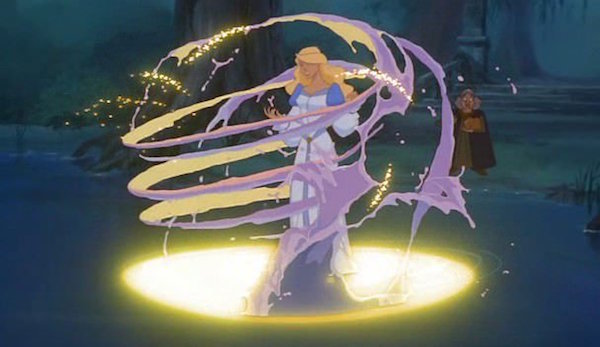
Their scenes do tend to break up the pacing of the film, but they are a lot more entertaining than Derek and Odette or the Derek Learns to Shoot a Bow subplot, and a lot more relevant than the subplot of Derek’s mother trying to get Derek married off to another princess, and dragging in princesses from around the world to meet him. That last is from the ballet, I know, but it keeps interjecting itself into the film just as the plot is getting exciting, and the film probably would have been better off had that bit been worked in, I dunno, mostly before Odette and friends are frantically trying to escape to save the kingdom.
The film does have a gloriously sappy ending, if you are into such things, and I kinda am. It would be a touch more meaningful if the relationship between Derek and Odette had been developed at all beyond the opening number, or if Odette hadn’t suddenly switched from “I refuse to marry Derek because of one tactless comment!” to “Derek is my true love which means I can’t possibly kiss any frogs!” with no intervening scenes to explain this change of heart, but, still, gloriously sappy is gloriously sappy.
The Swan Princess also has its genuinely lovely moments—for instance, the introduction of Swan Lake, with its ruined palace wrapped in mist, suggesting that Rich had learned something from Disney other than How To Steal From and Trace Previous Animated Work. And its definitely got amusing moments, most from Jean-Bob and Speed the Turtle, but from a few minor characters as well. The songs are generally entertaining and sometimes even clever. One, “Far Longer Than Forever,” even earned the film a Golden Globe nomination. Jack Palance, at least, seems to be having a lot of fun, and as said, Steven Wright as a turtle is, well, Steven Wright. As a turtle. It’s kinda great.
But it’s still derivative, wannabe Disney—to the point of adding an unnecessary reference to Disney’s The Three Little Pigs—with far too many animated sequences and scenes not just inspired by, but outright stolen from, previous Disney films. Rich was neither the first nor last animator/animated film director to do this, of course, and certainly not the last to do so with a touch (or more) of animus towards Disney. But Shrek, pulling some similar stunts less than a decade later, at least had the dignity to play this for laughs. Rich did so while trying to prove that he could create a Disney film.
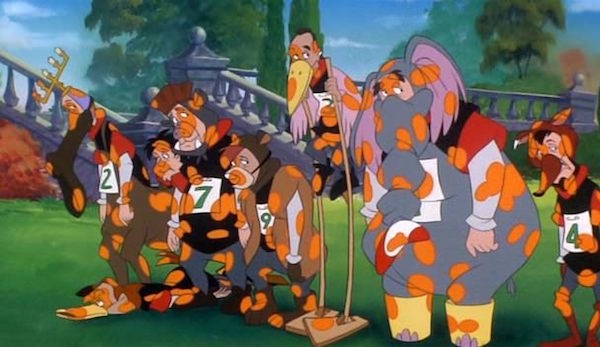
Nor does it help that Disney’s takes on Tchaikovsky’s other two ballets, The Nutcracker and Sleeping Beauty, had used his music to create original story and art. Rich stole Tchaikovsky’s story, without using his music, and then stole animation from Disney. Sigh.
The Swan Princess also suffers from pacing problems, and major plot inconsistencies. For instance, at one point, Rothbart tells Odette that he can’t have her kingdom unless they wed; a few scenes later, and he’s abandoned that plan in favor of letting her die by forcing Derek to confess his undying love to another woman. Ok, sure, but what happened to the Take Over the Kingdom By Marriage Deal, which was your main goal just minutes ago? If Derek can rush back to and back from the enchanted lake in one day, why hasn’t he found the lake before (the film makes a point of saying that he’s been searching everywhere for her, and, again, she’s one day’s run/walk away). For that matter, why hasn’t Odette found him well before the hunt for the map? She does fly around, after all. Why the complicated plan to try to lead Derek back to the lake when, in swan and puffin form, the animals can’t talk to him, and they have no reason at this point to believe that Derek has any reason to follow a swan and a puffin. The ruined castle has pen and ink (seen in the map chase scene), and we know Odette is literate: why not simply write Derek a note and have Puffin take the note to Derek?
And my biggie: the king and the princess of the neighboring kingdom—close enough to allow annual visits, and that kingdom’s closest allies, have suddenly vanished, and everyone’s like, ok, let’s have tea and make fun of the prince for trying to train himself to hunt for the missing princess? Oh, and have a ball. Not one thought of—hey, you don’t think whatever came after them will come after us next, do you?
In other words, great concept—the original ballet has survived for over a century now, after all—questionable execution.
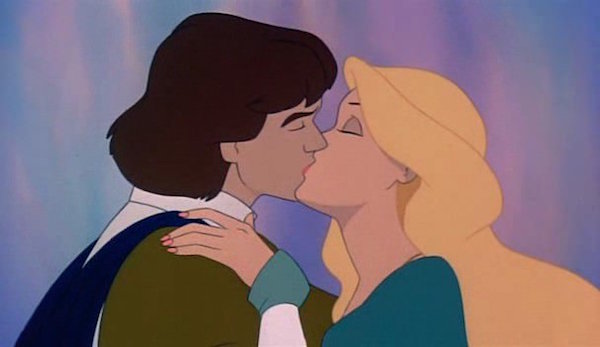
All of this probably explains why The Swan Princess ended up flopping at the box office—though Disney’s rather petty decision to rerelease The Lion King on that same weekend presumably didn’t help. The film brought in only $9.7 million at the box office, far less than its reported $21 million budget, not to mention far behind the numbers enjoyed by Disney films, even by the comparatively disappointing standards of The Rescuers Down Under (1990) which only brought in $47 million. The Swan Princess was able to recoup many of these costs in later video sales—but still had to deal with the sting of earning less overall than many of Disney’s direct-to-video releases. Any potential merchandising hopes, naturally, tumbled.
Buy the Book
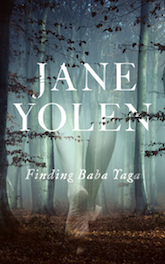

Finding Baba Yaga: A Short Novel in Verse
Despite this, Rich still believed in the film and his studio. As I type, The Swan Princess has spawned a grand total of six sequels, none of which I’ve seen. All were released direct-to-video, presumably a sign of their quality, but all helped keep Richard Rich’s animation studio alive during later troubled productions. And financially troubled nearly all of them were. The 1999 The King and I was a box office flop. The 2001 The Trumpet of the Swan, which had the horrible luck of getting released by Tristar just one week before Shrek, was an even worse box office flop, earning, as I type, a grand total of just $102,202 at the worldwide box office—one of the worst performing animated films of the past three decades. (Some limited-release international animated films did perform worse in the United States, but generally managed a better worldwide box office total.)
I have mixed feelings about this. The Swan Princess is not a great movie, let alone an original one. But here and there, in its background art, its songs, and its animal characters, it showed potential. With better pacing, slightly more interesting protagonists, and, well, more overall thought, it—and Rich’s studio—could have been great.
Alas, that didn’t happen, but we do at least have a film and six sequels, all of which might very well entertain your kids.
Mari Ness lives in central Florida.










